On September 21, the NMPA (National Medical Products Administration) released the administrative measures (draft) for cosmetics labeling in China. The draft covers new measures as highlighted below:
- Permission to utilize electronic labels for cosmetics with small-sized packaging whilst the text “electronic label” must be clearly indicated
- Permission to address the labeling information in the user manual or electronic label instead if the small-sized packaging of the cosmetic product does not provide enough space
- If new terminologies are used on the packaging, their respective definitions should be indicated close by
- Scientific evidence should be provided in detail for claims of efficacy, and the corresponding report should be prepared and published on the NMPA’s website accordingly
On September 28, the NMPA released three draft regulations including specific measures for imported cosmetics and ingredients:
Good manufacturing practices (GMP)
The draft GMP reflects the quality control requirements of “Practice for Cosmetics Production Licensing” issued in 2015 and aims to solve issues found in regulatory and supervisory practice.
According to the new CSAR (Cosmetics Supervision and Administration Regulation), cosmetic registrants, filers, and entrusted production companies should coordinate the cosmetics production in accordance with the requirements of the GMP for cosmetics and establish a cosmetics production quality management system to realize the control and traceability of the entire process of cosmetics material procurement, production, inspection, storage, sales, and recall. The GMP is divided into nine chapters, covering all aspects of cosmetic production and quality control:
• Chapter I General Rules
• Chapter II Institutions and Personnel
• Chapter III Quality Management
• Chapter IV Quality Control
• Chapter V Plant Facilities and Equipment
• Chapter VI Ingredients and Products
• Chapter VII Production Management
• Chapter VIII Product Sales Management
• Chapter IX Supplementary Rules
• Annex I Electronic Record Requirements for Cosmetics Production
• Annex II Environmental Requirements for Cosmetics Production Workshop
Specific measures for imported cosmetic ingredients:
- Safety information and related document of proof should be obtained from the suppliers of imported ingredients and documented for future references
- List of imported ingredients should be indicated with a corresponding Chinese name
Measures for adverse reactions
Cosmetic companies will carry more responsibilities for cosmetic adverse reactions monitoring and management, increasing industry self-regulation and enhanced product post-market surveillance:
- NMPA must be notified immediately if any adverse events, product recalls, or safety alerts occurred outside of China
- According to the investigation results of the adverse event, all provincial MPAs can coordinate with the NMPA to stop the importation of cosmetics if necessary
Sampling inspection
Local MPAs will be in charge to arrange regular or occasional sampling inspections for cosmetics. Cosmetic manufacturers, operators, domestic registrants/filers, DRA (domestic responsible agents) and e-commerce platform operators will have to fully cooperate during sampling inspections.
- The certificate of entry inspection and quarantine of imported cosmetics must be prepared before the sampling inspection
- Chinese labeling is required
- Non-conformities would require necessary actions to be taken, including product recalls, self-inspection, investigation on cause, and risk evaluation
On September 16, the NIFDC (National Institutes for Food and Drug Control) initiated the public consultation on the safety and technical standards for cosmetics (2015 edition) for future plans to draft an amended version.
By Jacky Li. Contact Cisema if you would like to learn more.

 Deutsch
Deutsch  Italiano
Italiano  Français
Français  日本語
日本語  한국어
한국어 



